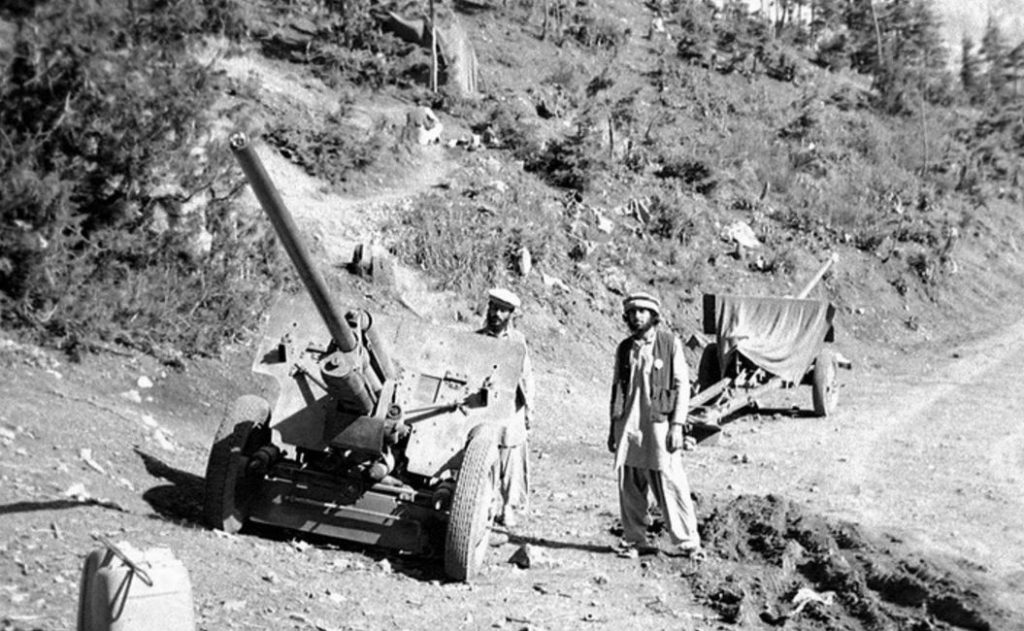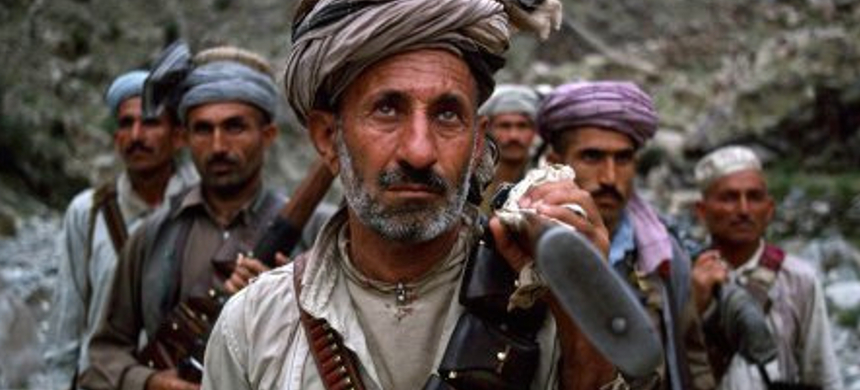When Humanitarianism Became Imperialism
IN FOCUS, 19 Sep 2016
Gregory Afinogenov – Jacobin Magazine
How the failed politics of “humanitarian intervention” were born in 1980s Afghanistan.
17 Sep 2016 – In 1980s Afghanistan, two world powers converged on each other, obliterating the national borders that stood in their way. The first was the Soviet state, bent on defending the precarious gains of a 1978 Communist coup d’état that it had actively tried to prevent. The second, caught in an even more painful paradox, was an uneasy alliance of foreign-funded jihadists, Western intelligence, and NGOs like Doctors Without Borders.
The way we remember the Afghan War today is as a kind of prologue. We care that the United States (along with, far more importantly, Pakistan and Saudi Arabia) helped fund jihadists because those insurgents would later turn against the United States, serving as the ultimate indictment of Reaganite Cold War politics. We care that the Soviet Union failed in Afghanistan because that failure foreshadowed the Afghan quagmire of today. We care about the Afghan War because it spawned Osama bin Laden.
Timothy Nunan’s new book, Humanitarian Invasion: Global Development in Cold War Afghanistan, shows how incomplete this retrospective, US-centric view is. Though he does not venture beyond the 1990s, his argument is essential for understanding the world of imperial warfare today.
Afghanistan did not create the Islamic State, but it did serve as the laboratory in which the destruction of Third World sovereignty came to be fitted with justifications rooted both in human rights and in regime security — the recipe for modern “humanitarian interventions.”
Sovereignty in Afghanistan, Nunan explains, was troubled from the beginning. In 1893 the British and Afghan governments created the Durand Line between Pakistan and Afghanistan, slicing through the homelands of Pashtuns and other ethnic groups who lived there.
Despite confirmation by successive international treaties, the line existed largely on paper, ignored by local residents whose connections across the borders were far stronger than they were either to Kabul or to Islamabad.
Nonetheless, the Durand Line became central to the geopolitical imaginaries of both countries. Pakistan saw the line as a buffer against the Soviet Union, as well as an opportunity to extend its influence northward through the Afghan Pashtuns. Afghan leaders — themselves generally Pashtuns or heavily influenced by Pashtun elites — tried to use development aid from both the Soviet Union and the West to create a purified ethnonational Pashtun state sealed off from Pakistani influence.
After the 1978 coup, the Pashtun Khalq faction within the Afghan Communist party — the People’s Democratic Party of Afghanistan (PDPA) — quickly dispatched its rival Parcham faction and began to pursue ethnic nationalist policies, while Pakistan mobilized the Pashtun and Baluch populations on its side of the line to fight an insurgent campaign to the north.
But this conflict over the future of “Pashtunistan” and the Afghan presence along the line became an ideological conflict as well. As they had done for decades, Afghan leaders appealed to socialist values and internationalist goals to pressure the Soviet Union into maintaining its support for Kabul, while Saudi financing (coming in part from the windfall generated by the 1970s oil crisis) turned the southern insurgency into a worldwide Islamist project.
Why Washington jumped on an opportunity to strike a blow at the Soviet Union is not hard to figure out. But why were they joined so enthusiastically by idealistic Western humanitarians? As Nunan argues, the modern international NGO moment, at least its European side, owes its existence to the disillusion of the Left after 1968.
The legacy of opposition to the Vietnam War combined with the lack of revolutionary progress in the West produced a new kind of ethos among European leftists. Solidarity with suffering people targeted by state repression, whether in right-wing Nigeria during the Biafran War or in newly communist Vietnam during the “Boat People” crisis, came to take precedence over grudging support for either Soviet or Chinese-aligned governments. This was the moment that gave birth to Doctors Without Borders in France and the Swedish Committee for Afghanistan in Sweden.
Both groups opposed Soviet intervention as imperialist and, eventually, supported the Islamist insurgency as a genuine expression of the popular will. Their powerful lobbying in their home countries and the United Nations meshed neatly with US foreign policy priorities, expressed most concisely in Carter national security adviser Zbygnew Brzezinski’s words, “we now have the opportunity of giving to the USSR its Vietnam War.” But the NGOs also helped the mujahidin directly, providing them with industrial equipment and embedding with them to spread their message to sympathetic Western audiences.
Today, of course, the United States and its NATO allies routinely instrumentalize human rights in the service of empire. Before the war in Afghanistan, however, such considerations were secondary: although anticommunists always emphasized the atrocities committed by Communist governments, this was just one of the many reasons to prop up a right-wing dictator or a military junta.
Afghanistan fundamentally altered this logic. Popular insurgencies were once assumed to be left-aligned; now Western interventions are almost always undertaken against a state on behalf of its people, from the Contras to the Kosovo Liberation Army.
Ideological arguments are no longer fashionable: in the face of state repression, we’re not expected to dig too deeply into the politics of Ahmed Chalabi in Iraq or the National Transitional Council in Libya, though the post-Afghan experience has required that such groups have at least a nominal claim to be “moderates.”
Instead, what justifies intervention is solidarity between human beings as suffering victims of repression, a claim so powerful and universal that it is held to override any talk about the efficacy of past interventions or the plan for what happens after a regime is overthrown.
It is no coincidence that the absence of any such plan is the defining characteristic of Western intervention since Afghanistan. The aim of the anti-Soviet insurgency was, from the beginning, to undermine Afghan sovereignty over the Durand line. On this Pakistanis, Saudis, and Americans could all agree: the Pakistanis because it expanded its power in the region, the Saudis because it could fuel an ever more transnational Islamist movement in its interests, and the Americans because it could weaken and destabilize the Soviet Union.
Ideologies that emphasized cross-border, antigovernment solidarity — whether Islamist or humanitarian — were an ideal fit for this project. But once the Soviets withdrew, what this strategy left in their place was a failed state. Its horrors led to the swift departure of the very Westerners who had helped to midwife it in the first place — a situation now playing out throughout the Middle East and once again in Afghanistan itself.
The alternative that the Soviet Union offered to the transnational ideology of the NGOs and Islamists was an authoritarian socialism-in-one-Third-World-country, in this case the Kabul government. Nunan makes clear how flawed this vision, too, proved to be. Not only did this implicate the Soviets in the atrocities committed by the Pashtun-supremacist Khalqi government; it was also routinely violated by the Soviets themselves.
In a memorable example, the Soviet Border Force effectively pushed the Soviet border south into Afghanistan by a hundred kilometers, creating a zone of lawless killing in a newly established frontier region. Even as the Soviet Union mouthed platitudes about sovereignty, it was helping to destroy the fragile territorial integrity of the Afghan state.
If the logic of transnational solidarity became the basis for Western interventions after Afghanistan, the logic of the Soviet alternative has been reproduced in many of today’s left-wing responses to these interventions, even as the regimes in whose name they are issued have less and less in common with socialism.
Though the extreme version of the argument — that we must support any regime that resists US imperialism, no matter how authoritarian, or, increasingly, neoliberal — is uncommon, we are routinely asked to stand in solidarity with Assad and Yanukovych. This echoes all the perversities of the Soviet stance: the defense of sovereignty is held to justify territorial annexation, partition by proxy forces, and the mass killing of civilians.
If we are to overcome the legacy of the Soviet war in Afghanistan, we can no longer pretend that the PDPA and the Soviet occupation forces were a viable alternative to the mujahidin. The only politics that offers a way out of the dilemma of contemporary Third World sovereignty is an internationalism that recognizes that its subjects are political actors, not just suffering subjects; that the repression launched by struggling secularist regimes undermines secularism just as it invites intervention; that the beneficiaries of Western intervention are to be found in Moscow, Riyadh, Arlington, and Islamabad, not Homs and Benghazi; and that the struggles of global refugee diasporas are coextensive with the domestic political communities they were forced to leave behind.
A politics that demands we think about interests and outcomes before we allow ourselves to be pressed into action by urgent moral appeals would restore politics to a climate long dominated by the depoliticizing discourse of suffering. It would also mean paying attention to who is being addressed. A demonstration about Syrian intervention is not, fundamentally, about Syria: it is about what our domestic security states plan to do there.
That gap, between internationalism and national politics, is what the former ‘68ers missed as they tried to put their dream of solidarity into practice in Afghanistan. In tracing that dismal story, Humanitarian Invasion says little about the events of the last two decades, but it is essential for understanding how they came to be.
____________________________________
Gregory Afinogenov is a lecturer in the history department at Harvard University.
Go to Original – jacobinmag.com
DISCLAIMER: The statements, views and opinions expressed in pieces republished here are solely those of the authors and do not necessarily represent those of TMS. In accordance with title 17 U.S.C. section 107, this material is distributed without profit to those who have expressed a prior interest in receiving the included information for research and educational purposes. TMS has no affiliation whatsoever with the originator of this article nor is TMS endorsed or sponsored by the originator. “GO TO ORIGINAL” links are provided as a convenience to our readers and allow for verification of authenticity. However, as originating pages are often updated by their originating host sites, the versions posted may not match the versions our readers view when clicking the “GO TO ORIGINAL” links. This site contains copyrighted material the use of which has not always been specifically authorized by the copyright owner. We are making such material available in our efforts to advance understanding of environmental, political, human rights, economic, democracy, scientific, and social justice issues, etc. We believe this constitutes a ‘fair use’ of any such copyrighted material as provided for in section 107 of the US Copyright Law. In accordance with Title 17 U.S.C. Section 107, the material on this site is distributed without profit to those who have expressed a prior interest in receiving the included information for research and educational purposes. For more information go to: http://www.law.cornell.edu/uscode/17/107.shtml. If you wish to use copyrighted material from this site for purposes of your own that go beyond ‘fair use’, you must obtain permission from the copyright owner.

